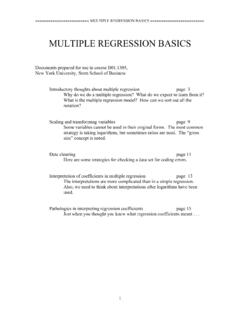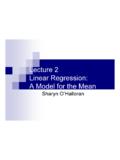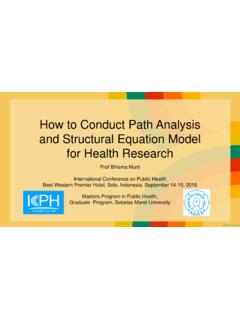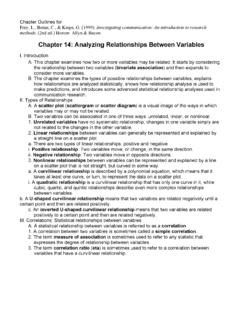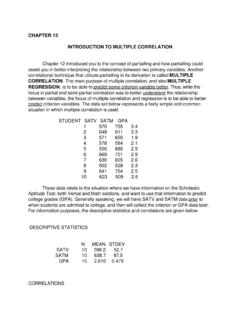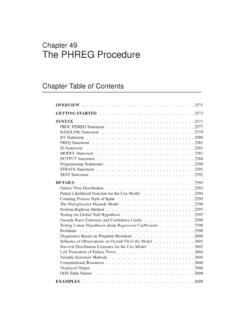Transcription of Using regression analysis to establish the relationship ...
1 International Education Journal, 2006, 7(5), 632-641. ISSN 1443-1475 2006 Shannon Research Press. 632 Using regression analysis to establish the relationship between home environment and reading achievement: A case of Zimbabwe Gibbs Y. Kanyongo School of Education, Duquesne University Janine Certo School of Education, Duquesne University Brown I. Launcelot School of Education, Duquesne University In this study, we report results of a study examining the relationship between home environment factors and reading achievement in Zimbabwe. The study utilised data collected by the Southern and Eastern Africa Consortium for Monitoring Educational Quality (SACMEQ). The data were submitted to linear regression analysis through structural equation modelling Using AMOS In our results, we showed that a proxy for SES was the strongest predictor of reading achievement. Zimbabwe, reading achievement, home environment, linear regression , structural equation modelling INTRODUCTION Past research has indicated that a significant relationship exists between children's home environment and reading achievement.
2 However, most such studies have been conducted in Western countries where the concept of home environment is different from that in developing countries. In developed countries, almost all students have amenities like electricity and piped water in their homes, and these factors are never thought of being influential in a student s academic performance. In the current study, the home environment factors considered among other factors were: possession of such things like piped water, electricity, refrigerator and TV. Collectively, these possessions were taken to be a measure of social economic status (SES). SES, together with several other factors were used as measures of the students home environment. The student s score on a reading test was used as a measure of reading achievement. The study utilised a sample of 2697 sixth grade students who were randomly sampled across the schools in Zimbabwe.
3 Purpose of the study The purpose of this study was to investigate the relationship among home environment variables and reading scores among Grade 6 students in Zimbabwe. The study is based on the data collected by the Southern and Eastern Africa Consortium for Monitoring Educational Quality (SACMEQ) during the period 1995 1998 under the auspices of the International Institute for Educational Planning (UNESCO-IIEP, 2004). The data were collected during the first educational research policy project named SACMEQ I covering seven Southern African countries, and Zimbabwe was Kanyongo, Certo and Launcelot 633 one of the seven countries. Specifically, the current study seeks to answer the following two major questions: a) What family environment variables are predictive of reading achievement among Grade 6 students in Zimbabwe? b) How strong are family environment variables at predicting reading scores among Grade 6 students in Zimbabwe?
4 PREVIOUS RESEARCH AND THEORETICAL FRAMEWORK There is a considerable body of theoretical and empirical work that suggests that home environment, in general, plays a crucial role in student learning and achievement (Walberg, 1999). Research focusing on home environment variables continues to be of merit, for Parcel and Dufur (2001), in their National Longitudinal Survey of Youth (NLSY), found that parental and material resources in the home (what they termed capital effects ) were stronger than school effects. The theoretical mechanisms that may explain the effect of home environment on child outcomes are related and numerous. Social capital theory (Coleman, 1988; Parcel and Dufur, 2001). Thus, social capital and resources at the country or family level, provide students with advantages for being successful at school (Aru, 1998; Bradley and Corwyn, 2002; Heyneman and Loxley, 1982). Such resources also benefit students indirectly through an increased number of cultural opportunities and better health standards (Murphy et al.)
5 , 1998; Neisser et al., 1996). A causal mechanism directly discussed in the literature is socio-economic status (SES). It is no longer questioned that low income leads to negative consequences for children (Duncan and Brooks-Gunn, 1997). Children living in poverty face developmental deficits that are most likely due to the inability of high-poverty families to provide adequate food, shelter, and other material goods that foster the healthy cognitive development of children (Duncan, Brooks-Gunn, and Klebanov, 1994; Hanson, McLanahan, and Thomson, 1997; Korenman, Miller, and Sjaastad, 1995). A meta- analysis of 101 related studies (White, 1982) suggested that when home atmosphere or environment was used as an indicator of SES, relatively high correlations were found between SES and academic achievement. Chui and Khoo (2005) found that 15-year-old students across 41 countries (N = 193,076) scored higher on tests in mathematics, reading, and science when they had more economic resources in their country, family and school.
6 The positive log-linear effect of per capita GDP was consistent with past research showing that students in richer countries benefited from more nutritious food, books in the home, and better health care, all of which, in turn, supported higher academic performance (Alaimo, Olson, and Frongillo, 2001; Murphy et al., 1998; Neisser et al., 1996). Results were consistent with other studies in that girls scored higher in reading but lower in mathematics and science (National Center for Education Statistics, 2003; Third International Mathematics and Science Study Group, 1995). In general, parent job status and parent education seems to have different effects (Chui and Khoo, 2005). Parents higher job status and mother s education improved the academic performance of their child. A father s level of schooling, however, did not. These results mirror other studies showing that parents social networks and mother s schooling affected students academic performance more than did father s level of schooling (Stafford and Dainton, 1995).
7 Researchers have not only found that adolescents from lower income and less-educated families performed less well in school, but those from single-parent and large families fared less well in school than their counterparts from higher income, better-educated, two-parent and small families (Astone and McLanahan, 1991; Sputa and Paulson, 1995). Stevenson and Baker (1987) found that the educational level of parents explained more of the variability in school achievement than did 634 Using regression analysis between home environment and reading achievement other family demographic characteristics. This might be explained by the theory that caregivers with more human capital had greater education and skills, which they could draw upon to teach their children cognitive and social skills and social and cultural norms (Och, Taylor, Rudolph, and Smith, 1992; Snow, Perlmann, Berko Gleason, and Hooshyar, 1990; Swick and Broadway, 1997).
8 Again, since mothers were the primary caregivers in many homes, their human capital generally affected their children s performances more than did the a father (Darling-Fisher and Tiedje, 1990; Emery and Tuer, 1993; Stafford and Dainton, 1995). There are factors in the home environment that have all been found to be associated specifically with reading achievement. Not surprisingly, these include financial and material resources (Grissmer et al., 1994; Parcel and Menghan, 1990, 1994a, 1994b; Saracho, 1997a), number of children in the home (Blake, 1989; Coleman, 1988, 1990; Downey, 1995; Parcel and Menghan, 1990, 1994a, 1994b), parent education (Grissmer et al., 1994; Saracho, 1997a), mother s age (Grissmer et al., 1994), and caregiver investment in age-appropriate cognitive stimulation (Leseman and de Jong, 1998; White, 1982). The data are mixed, however, in regards to which home environment variables best predict reading success.
9 Several studies have demonstrated that increased numbers of children within the family lead to less favorable child outcomes, in general, probably due to resource diffusion (Blake, 1989; Downey, 1995; Parcel and Menaghan, 1990, 1994a, 1994b). Parcel and Menaghan (1993) found that children from larger families had lower levels of reading achievement. Coleman (1988, 1990) argued that even if the bond between caregiver and child was strong, it would not automatically result in improved child outcomes unless the child had access to parental resources. Researchers at the Rand Institute on Education and Training (Grissmer et al., 1994) found a relationship between children s reading achievement and parent s level of education, family income, and the mother s age. Although parent s education, occupation, and income have been found to be related to children s reading outcomes, some suggest that the actual characteristics of the home literacy environment that was created by the caregiver might be more important (Leseman and de Jong, 1998; White, 1982).
10 The recent term home literacy environment has generally referred to participation in literacy-related activities relegated to availability of print material and frequency of reading (Leseman and de Jong, 1998). Saracho (1997a) proposed that parent s literacy level and the availability of reading materials worked together as the primary characteristics of the home environment that related to a child s literacy development. Other research has extended the scope of the home literacy environment (Christian, Morrison, and Bryant, 1998; Griffin and Morrison, 1997; Payne, Whitehurst, and Angell, 1994) to include such variables as the age of the child when joint reading began, independent child or caregiver reading, and frequency of behaviours that interfered with reading (for example, television viewing). A factor often overlooked in research on the home environment is that a child may not live with a parent at all or may live away from them during the school week.










